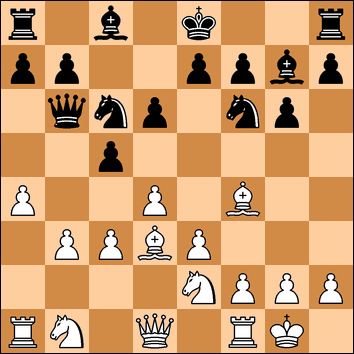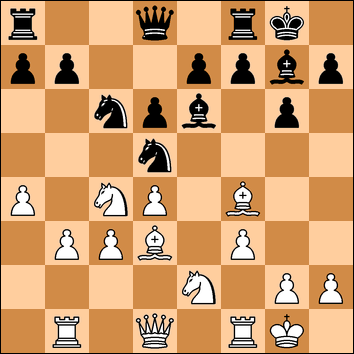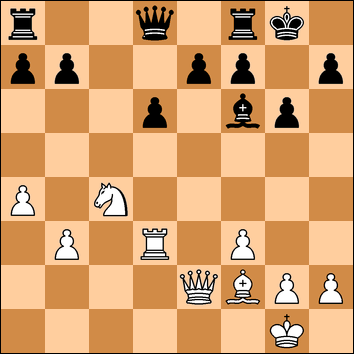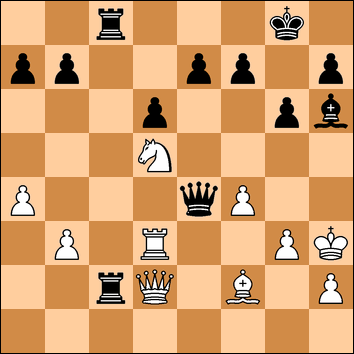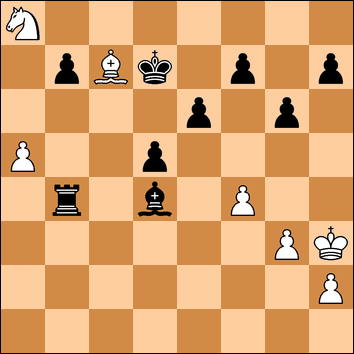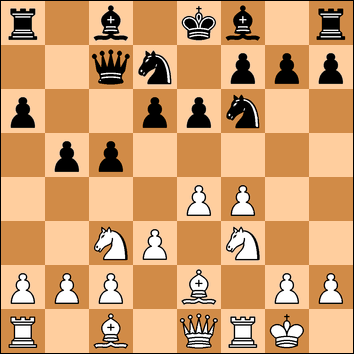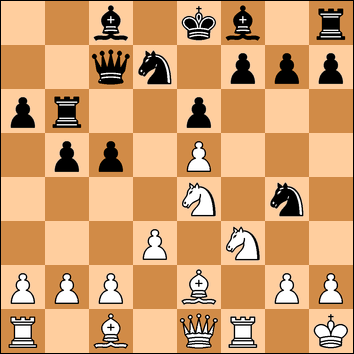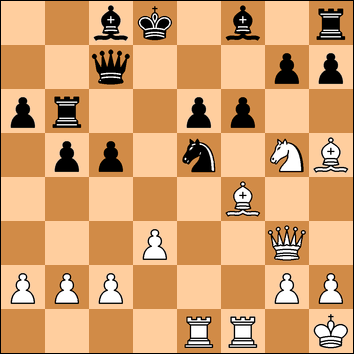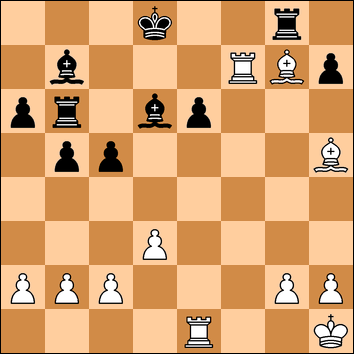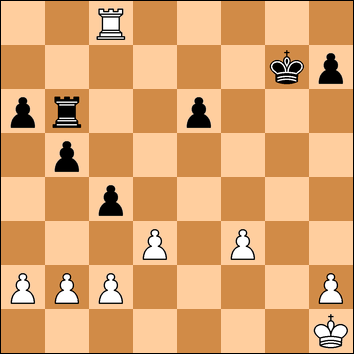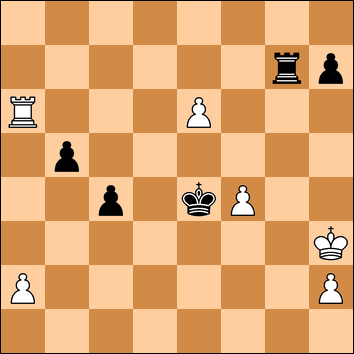Thursday 26 January 2017
White: K. Nevols (134) - Black: R. Lane (157)
The last game against my opponent (Game 20) has resulted in a dreadful defeat.
1. e4 c6
And, as in our previous encounter, he comes out with the Caro-Kann - at which time the game went 2. d4 d5 3. Nc3 dxe4 4. Nxe4 Nf6 5. Nxf6 gxf6!? and I went down in flames.
2. Ne2
My last game with this move (Game 42) was quite a success and so it was time to try it again.
2. ... d5
3. e5 c5
One of the three main moves along with 3. .. Bf5 and 3. .. d4. Normally Caro-Kann players do not like to move their c-pawn twice in the first three moves. Now I took some time to remember my theory.
4. d4 Nc6
5. c3
The computer likes 5. dxc5 and this could be worth a try. It did not look right to me but Black could play 5. .. Qa5+ 6. Nbc3 e6 and then it gives the line 7. Nd4 Nxd4 8. Qxd4 Bxc5 9. Bb5+! Qxb5 10. Nxb5 Bxd4 11. Nxd4 (or 7. ... Nxe5 8. Nb3 Qc7 9. Bb5+ Bd7 10. Bf4 Bxb5 11. Nxb5 Nd3+! 12. Qxd3 Qxf4). Better for Black is 5. .. e6 when he would be better after 6. f4 Nxc5 and equal after 6. Be3 Nxe5.
5. ... e6
Now we have a French-looking position. As it looks like my knight on e2 is not going anywhere for a while, I decide to develop the king's bishop the other way.
6. g3 Nge7!?
White could now take the opportunity that the Black king's bishop is blocked to play 7. dxc5 Nxe5 8. Nd4 (8. Be3??? Nf3 mate) Nec6.
7. Be3 Nf5
8. Bg2 Qb6
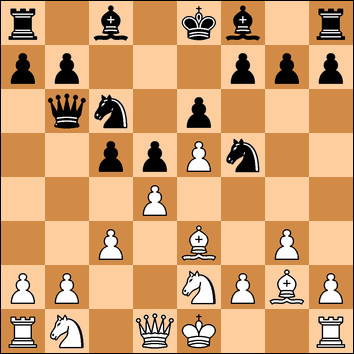
Now Black has the initiative and it's time for the thinking cap. There are threats to d4 and to b2.
9. Qd2
The move 9. Qc1 would be a slight improvement although Black remains better after 9. .. cxd4 10. cxd4 f6!.
Black can now seize the advantage with 9. .. cxd4. If 10. cxd4 then 10. .. Bb4 11. Nc3 f6.
If 10.Nxd4 then Nxe3 11. fxe5 Nxe5. If 10. Bxd4 then 10. .. Nfxd4 11. Nxd4 Nxe5 or 11. cxd4 f6.
The f6 break is a continual threat here yet oddly we both under-estimate its importance.
9. ... Bd7
10. O-O Be7
Now I felt a little more comfortable and saw a sequence to slightly free up my position.
11. g4!? Nxe3
12. fxe3 Bg5
13. Nf4 cxd4
The computer prefers castling to prepare f6 once again.
14. cxd4
I ruled out 14. exd4 for the simple reason of 14. .. Nxe5. However White has 15. Nxd5! and the sequence goes 15. .. Bxd2 16. Nxb6 Be3+ 17. Kh1 axb6 18. dxe5. Material is even - but Black is better.
14. .... O-O
15. Nc3 Rac8
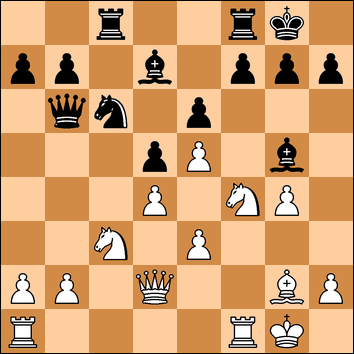
Now I felt a little more comfortable. I was beginning to sort out the position. Here 16. Rab1 is probably best to relieve the queen from the defence of the b-pawn. Instead I make a move which I quickly regret.
16. a3?
The idea was to follow up with b4 and maybe Na4-c5 making small advances on the queenside. However the move weakens squares and we are back on the ropes.
16. ... Na5
Of course, threatening Nb3 and moving in on the delicious c4 square.
17. Rab1 Nc4
18. Qf2
Blocking the queen-to-my-king diagonal and trying to hang on to everything. But now 18. .. f6 is very strong, opening the f-file.
18. .... a6
I now considered 19. h4 but that just gives another pawn that I have to defend. (19 .. Bxh4 20. Qxh4 Nd2 looked a bit dangerous but is probably OK). Instead I decided to shore up the defences - covering d2 and d4.
19. Rfd1 f6!
At last! Black now attacks and open lines - and again I grow concerned. At this point I did start thinking about whether there are any opportunities for tactics on the d5 point - as the diagonal to the king is now open. I parked that idea for the moment.
20. exf6 Bxf6
21. Qe2
Moving off the f-file seemed sensible and still defending e3. The d5 tactic now came to mind. Black should now play 21. .. Kh8 to avoid it.
21. .... Bg5?!
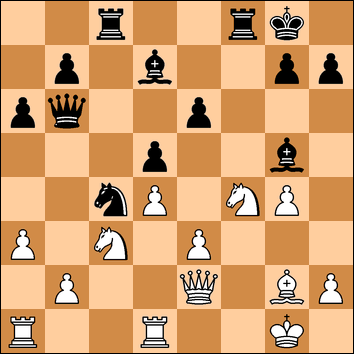
But he has overlooked it! I now had a think, and decided that, as I am under the cosh, the tactic was worth a go.
22. Ncxd5!?
I was looking at 22. ... exd5 23. Bxd5+ Kh8 24. Bxc4 and I am two pawns up - and that is as far as I got.
But Black can quickly strike back with 24. ... Bxf4 25. exf4 Rxf4.
Then if 26. h3 Bxg4!! (if 26. .. Rxd4 27. Qf2 Rxd1+ 28. Rxd1 Qxf2+ 29. Kxf2 Bc6 and the position is level) 27. hxg4 Rxd4 28. Rxd4 Qxd4+ 29. Kh1 Qxc4 and Black is a pawn up with the better position.
It is not easy to see this far (especially 26. .. Bxg4) and, after a think, Black decided to let the pawn go.
22. ... Qb3
Now I am back in the game.
23. Rd3 Qb5
The computer now recommends 24. a4 Qa5 (24. ... Qxa4 25. b3 which I did not see) 25. b3. Instead I wanted to move my en prise knight with tempo before I lost it.
24. Nc3 Qb6
Now I went into the tank - again trying to see how I can save the creaky position. I am a pawn up but Black has pressure down the f-file, with the bishops, and along the b6-g1 diagonal. The immediate threat is Bxf4 winning a pawn. So I decide to defend that.
25. Qf2?
But this loses. White should have played 25. Ne4! which I did not see at all. Then 25. .. Bxf4 26. exf4 Rxf4 27. Nc5! - a wonderful square for the knight with threats on b7 and d7.
25. ... Nxe3
Immediately getting the pawn back.
26. Qxe3
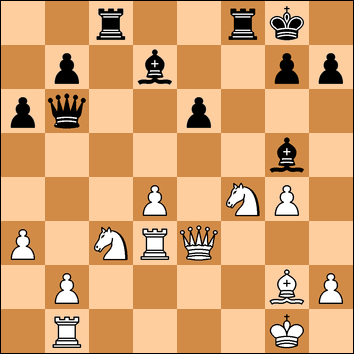
26. ... Bxf4?
But Black goes wrong. 26. .. Rxf4 was far stronger, threatening a discovered attack, the pawn on g4 and the pawn on d4. White might have to hang in there with 27. Qg3 Rxd4 28. Rxd4 Qxd4+ 29. Kh1 but Black is a pawn up - and a passed pawn to boot. He could soon start thinking about e5-e4-e3 etc.
27. Qe1
I decided that my only hope of coming out of this alive was to attack!
27. ... Qc7
28. Qh4 Bc6
Rf6 is better. My gamble is working.
29. d5!
A repeat of the earlier tactic.
29. ... Bxd5
30. Nxd5 exd5
31. Bxd5+ Kh8
I now tried to see if I could somehow get a swindle and win this game.
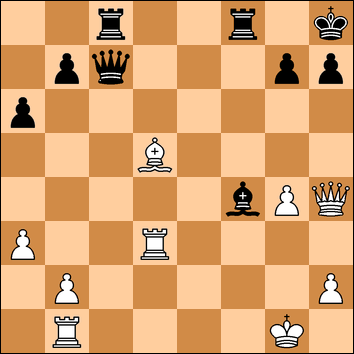
32. Be4 h6
33. Rbd1
Planning Rd7 but now Black can play 33. ... Qb6+ 34. Kh1 Qxb2 and 35. Rd7 could be answered with 35. ... Rd1! Things might get a bit wild but Black should be able to defend and exploit his advantage.
33. ... Bg5
34. Qh5 Qf7
Another option is 34. ... Qb6+ 35. Kh1 Rce8! and then 36. Qg6 Qxg6 37. Bxg6 Re2 with an edge but White might have enough play to hold.
35. Qxf7 Rxf7
36. b3
With a draw in mind, just moving the pawn off a Black square.
36. .... Rb8
37. Rd7 Rxd7
38. Rxd7
And I offered a draw which was accepted. A clearly even position.
Swale v Maidstone
Keith Nevols (134) 1/2-1/2 Robert Lane (157)
Tyrone Jefferies (116) 1/2-1/2 Ian Clark (141)
Andrew Gillard (113) 1-0 Christopher Wise (79)
Will Foster (45) 0-1 Robert Cox (63)
Swale 2-2 Maidstone
